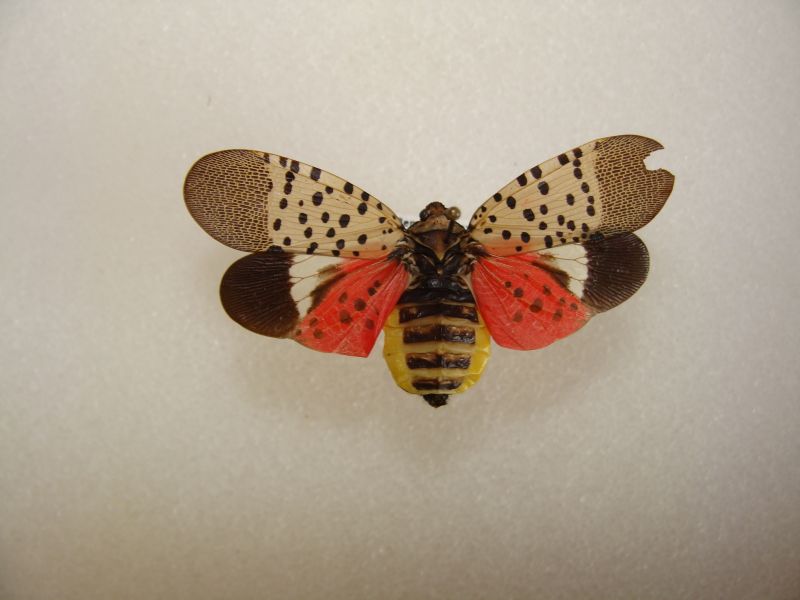An invasive insect that has damaged agricultural crops in the Northeast United States and creates a black sticky mess on homeowners’ trees that stinks of sour vinegar has been found in Virginia.

Now, officials are hoping citizens in the region will help monitor and track the movement of the pest known as the spotted lanternfly.
“We think we could see them covering homeowners’ trees in numbers that could even be worse than the 17-year cicadas,” said Eric Day, manager of the Virginia Tech Insect Identification Lab, which is helping monitor the spotted lanternfly’s geographic reach. “We are still determining how bad this impact is going to be on both agricultural producers and homeowners.”
The insect prefers to feed on the invasive tree of heaven that is rampant around the state, but for much of its lifecycle, the spotted lanternfly will attack apple and pear trees, hops, grapes, and other valuable crops.
An adult spotted lanternfly is approximately 1-inch long and 1/2-inch wide. The forewing is grey with black spots and the wing tips have black blocks outlined in grey. The hind wings have contrasting patches of red and black with a white band that are visible when it flies. The legs and head are black; the abdomen is yellow with broad black bands. During immature stages, it is black with white spots and develops red patches as it grows.
If anyone sees the signs of the pretty but destructive insect or its eggs, they are asked to fill out a form noting their location. Photos of the insect or its eggs are encouraged. People can also report sightings to the Virginia Department of Agricultural and Consumer Services at 804-786-3515 or email Virginia Cooperative Extension at spottedlanternflyvirginia@gmail.com. More information on the pest can be found at Virginia Cooperative Extension’s topic page.
“It is vitalt hat we learn where the insects are spreading around the state so we can develop ways to stop their movement and build a strategy to limit their damage,” said Doug Pfeiffer, an entomologist with the Virginia Tech College of Agriculture and Life Sciences and a Virginia Cooperative Extension specialist.
The volunteer Master Gardeners around the state are also tracking the spread of the bug using sticky tape to trap the insects as they climb up trees of heaven – which are also called ailanthus or paradise trees.
The insects are native to China, India, and Vietnam, but moved into Korea in 2006, where it attacked more than 60 different plant and agricultural crops. In 2014, it was found in the U.S for the first time in Bucks County, Pennsylvania. Despite best efforts to control it, it has since moved into more than 15 Pennsylvania counties as well as Delaware, New Jersey, New York, and Virginia.
One of the challenges with containing the spotted lanternfly is the ease with which it can spread. In addition to host plants, it lays eggs on concrete, rocks, wood pallets, and vehicles, which are then moved around the state. When spotted lanternfly eggs and dead adults were discovered in Winchester, Virginia, earlier this year, they were located adjacent to a railway and highway. The egg masses began to hatch in May.
“They were found in a spot that creates a perfect storm,” Day said.
The lanternfly feeds on the tree of heaven because the chemical that gives the tree its distinct, pungent odor, also makes the insect taste bad when birds eat it. This taste makes birds less likely to eat the insect a second time.
Merely cutting down the trees of heaven to detract the spotted lanternfly doesn’t help. They will grow back up from the roots, often in bigger numbers, creating more feeding opportunities for the lanternfly. Researchers are looking into ways to control the trees of heaven.
Beyond the trees of heaven, the spotted lanternfly will also feed on more than 70 other host plants, including a wide range of agricultural crops.
When the spotted lanternfly is feeding on a plant, it secretes what is known as honeydew, a black, sticky, stinky substance that coats the plant and can cover the ground below. This promotes fungal growth, damaging the plants and attracting other insects. Grape growers have reported that yields have decreased from 4.5 tons per acre to about a half ton per acre after the lanternfly attacked the plants.
Officials are calling on people around the state be vigilant and report any sightings of the insect.
“We don’t know how bad it can get with this invasive insect,” Day said. “But the more we can learn about its movement, the better we can control it.”


